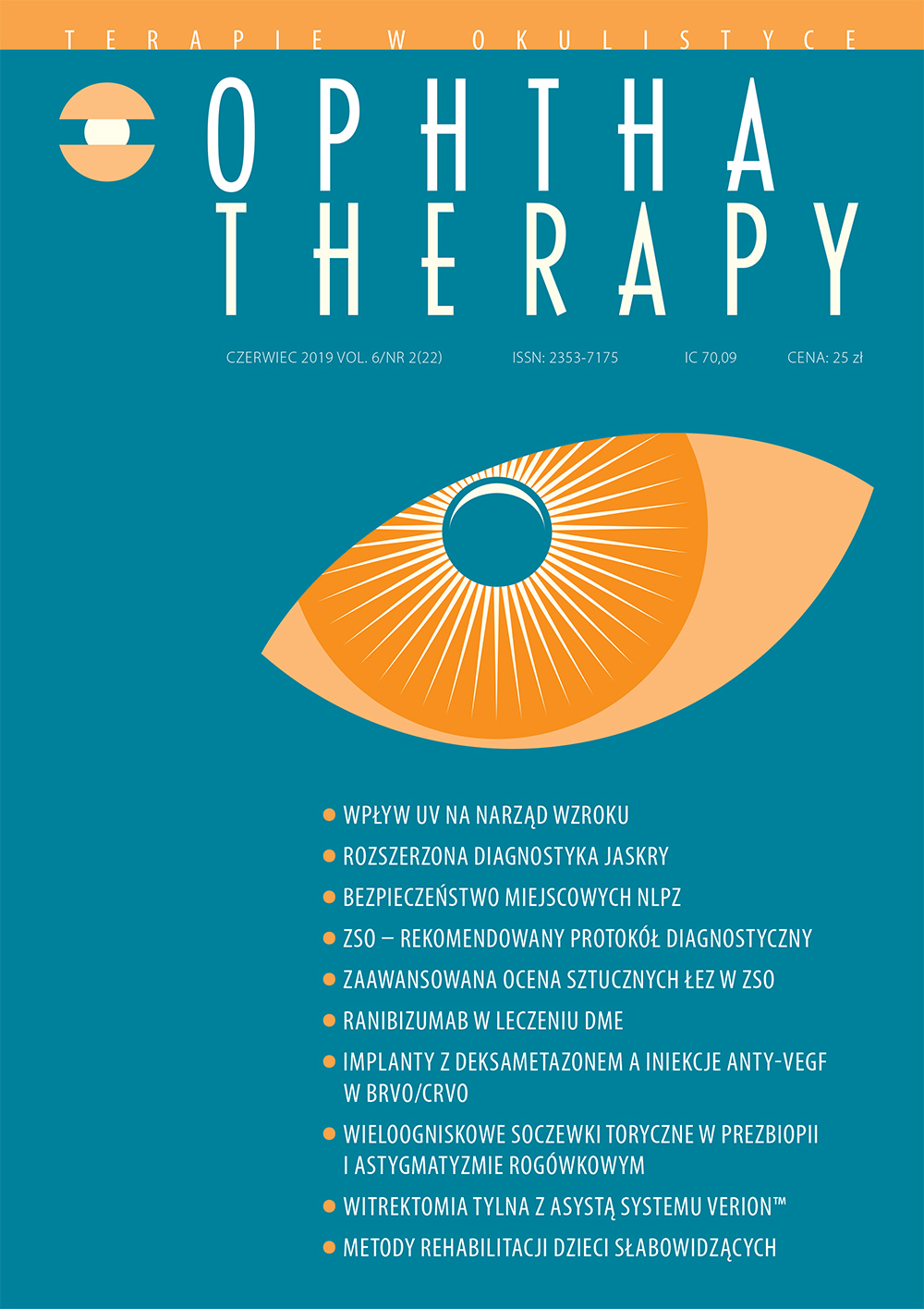Zastosowanie wewnątrzgałkowych wieloogniskowych soczewek torycznych w korekcji prezbiopii oraz astygmatyzmu rogówkowego w chirurgii zaćmy – analiza wyniku refrakcji i stabilności osiowej soczewki AcrySof IQ PanOptix TFNTx
##plugins.themes.bootstrap3.article.main##
Abstrakt
Cel: Celem pracy jest ocena wyników ostrości wzroku do dali, bliży i odległości pośredniej, refrakcji obiektywnej, keratometrii rogówkowej oraz stabilności rotacyjnej soczewki u pacjentów poddanych operacji zaćmy z implantacją wieloogniskowej soczewki torycznej AcrySof IQ PanOptix TFNTx w rocznym okresie obserwacji.
Materiał i metody: Do badania włączono 20 oczu 14 pacjentów. Poddano ich operacji zaćmy metodą koaksjalnej fakoemulsyfikacji z szerokością cięcia rogówkowego 2,2 mm oraz z implantacją soczewki AcrySof IQ PanOptix TFNTx. Przed zabiegiem oceniono ostrość wzroku do dali bez korekcji i z najlepszą korekcją, refrakcję obiektywną oraz keratometrię rogówkową. 12 miesięcy po operacji oceniono ostrość wzroku do dali bez korekcji i z najlepszą korekcją, ostrość wzroku do odległości pośredniej bez korekcji, ostrość wzroku do bliży bez korekcji, refrakcję obiektywną, keratometrię rogówkową oraz stabilność rotacyjną implantu w torebce.
Wyniki: W rocznym okresie obserwacji zanotowano istotną statystycznie poprawę ostrości wzroku do dali bez korekcji i z najlepszą korekcją (p = 0,005 oraz p = 0,016). Nie zaobserwowano istotnej statystycznie zmiany w wielkości keratometrii rogówkowej w południku płaskim i stromym (p = 0,94 oraz p = 0,63) oraz w wielkości cylindra rogówkowego (p = 0,49). Odnotowano istotne statystycznie zmniejszenie mocy cylindrycznej w refrakcji obiektywnej (p = 0,002). Średnie odchylenie osi wszczepionej soczewki od zaplanowanej osi implantacji wyniosło 2,51°. Nie zaobserwowano powikłań śród- ani pooperacyjnych u żadnego z pacjentów.
Wnioski: Implantacja wieloogniskowej torycznej soczewki AcrySof IQ PanOptix TFNTx jest bezpiecznym i efektywnym sposobem leczenia prezbiopii współistniejącej z astygmatyzmem rogówkowym w trakcie operacji zaćmy.
Pobrania
##plugins.themes.bootstrap3.article.details##

Utwór dostępny jest na licencji Creative Commons Uznanie autorstwa – Użycie niekomercyjne – Bez utworów zależnych 4.0 Międzynarodowe.
Copyright: © Medical Education sp. z o.o. License allowing third parties to copy and redistribute the material in any medium or format and to remix, transform, and build upon the material, provided the original work is properly cited and states its license.
Address reprint requests to: Medical Education, Marcin Kuźma (marcin.kuzma@mededu.pl)
Bibliografia
2. Lehmann R, Waycaster C, Hileman K. A comparison of patient-reported outcomes from an apodized diffractive intraocular lens and a conventional monofocal intraocular lens. Curr Med Res Opin. 2006; 22(12): 2591-602.
3. Hayashi K, Manabe S, Yoshida M et al. Effect of astigmatism on visual acuity in eyes with a diffractive multifocal intraocular lens. J Cataract Refract Surg. 2010; 36(8): 1323-9.
4. Ferrer-Blasco T, Montés-Micó R, Peixoto-de-Matos SC et al. Prevalence of corneal astigmatism before cataract surgery. J Cataract Refract Surg. 2009; 35(1): 70-5.
5. Sachdev GS, Sachdev M. Optimizing outcomes with multifocal intraocular lenses. Indian J Ophthalmol. 2017; 65(12): 1294.
6. Gundersen KG, Makari S, Ostenstad S, Potvin R. Retreatments after multifocal intraocular lens implantation: an analysis. Clin Ophthalmol Auckl NZ. 2016; 10: 365-71.
7. Kohnen T, Herzog M, Hemkeppler E et al. Visual Performance of a Quadrifocal (Trifocal) Intraocular Lens Following Removal of the Crystalline Lens. Am J Ophthalmol. 2017; 184: 52-62.
8. de Carneros-Llorente AM, de Carneros AM, de Carneros-Llorente PM et al. Comparison of visual quality and subjective outcomes among three trifocal intraocular lenses and one bifocal intraocular lens. J Cataract Refract Surg. 2019; 45(5):587-94.
9. García-Pérez JL, Gros-Otero J, Sánchez-Ramos C et al. Short term visual outcomes of a new trifocal intraocular lens. BMC Ophthalmol. 2017; 17: 72. https://doi.org/10.1186/s12886-017-0462-y.
10. Lehmann R, Modi S, Fisher B et al. Bilateral implantation of +3.0 D multifocal toric intraocular lenses: results of a US Food and Drug Administration clinical trial. Clin Ophthalmol Auckl NZ. 2017; 11: 1321-31.
11. Knorz MC, Rincón JL, Suarez E et al. Subjective Outcomes After Bilateral Implantation of an Apodized Diffractive +3.0 D Multifocal Toric IOL in a Prospective Clinical Study. J Refract Surg. 2013; 29(11): 762-7.
12. Kohnen T, Nuijts R, Levy P et al. Visual function after bilateral implantation of apodized diffractive aspheric multifocal intraocular lenses with a +3.0 D addition. J Cataract Refract Surg. 2009; 35(12): 2062-9.
13. Lane SS, Javitt JC, Nethery DA, Waycaster C. Improvements in patient-reported outcomes and visual acuity after bilateral implantation of multifocal intraocular lenses with +3.0 diopter addition: Multicenter clinical trial. J Cataract Refract Surg. 2010; 36(11): 1887-96.
14. Cochener B, Boutillier G, Lamard M, Auberger-Zagnoli C. A Comparative Evaluation of a New Generation of Diffractive Trifocal and Extended Depth of Focus Intraocular Lenses. J Refract Surg. 2018; 34(8): 507-14.

